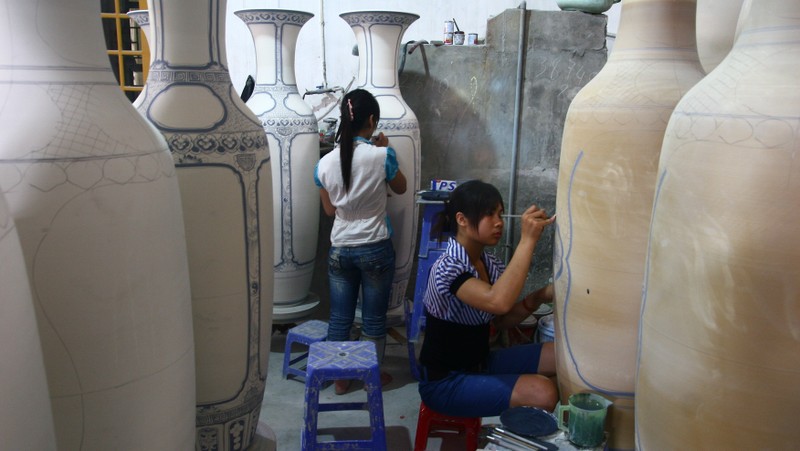The General Statistics Office late last week reported that the Vietnamese economy’s GDP grew by an optimistic growth rate of 6.9% year-on-year, “with continued macroeconomic stability, and the business climate continuing to be improved. The first-quarter’s number of newly-established enterprises has increased to a five-year high.”
“This rate is lower than the 7.45% in the same period last year, but much higher than the first-quarter growth rates in the 2011-2017 period,” said a GSO report on the first-quarter economic report.
To break down the figure, in the first three months of 2019, the agro-forestry-fishery grew 2.68%, contributing to 4.9% of economic growth, while the growth rate of manufacturing and construction sector is 8.63% – holding 51.2% of economic growth, and that of the service sector is 6.5%, accounting for 43.9% of economic growth.
“The key growth impetus in the first three months of the year came from the manufacturing and processing sector, which increased 12.35% on-year,” said GSO’s head Nguyen Bich Lam.
According to the GSO, in the first three months of this year, Vietnam’s index for industrial production climbed 9.2% year-on-year.
In which, the manufacturing and processing sector expanded at a high level of 11.1%, contributing an 8.5% increase to industrial production growth. The production and distribution of electricity – a vital input for the economy - ascended 9.4%.
If the mining sector did not decrease, Vietnam’s industrial production would have been increasing strongly as previously. In the first quarter of the year, this sector reduced 2.1%, leading to a 0.3% reduction to industrial production growth.
Also, according to the GSO, total revenue from retail activities and consumption services in the first three months hit about US$51.52 billion, up 12% year-on-year.
According to a GSO survey on Vietnamese businesses’ performance released last week, 45.6% of respondents expect their performance will improve in the second quarter of 2019, and 34.8% forecast their business will remain stable.
In the first quarter of 2019, Vietnam saw 28,451 newly-established enterprises, with total registered capital of VND375.5 trillion (US$16.33 billion), up 6.2% in the number of enterprises, and 34.8% in capital. Besides, operational enterprises increased their capital by another VND722.5 trillion (US$31.4 billion). Thus, total new capital inserted into the economy was VND1.098 trillion (US$47.74 billion).
Duong Manh Hung, head of the GSO’s Department for National Account Statistics, said that in the upcoming quarters, one of the big propellants of the economy may be the US$9.3 billion Nghi Son oil refinery and petrochemical plant and China’s Taiwanese-backed US$10 billion Formosa steel complex in the central region of the country.
The Nghi Son plant officially began commercial operation in late December 2018. Building work on the project began in 2013. It was funded through investment from PetroVietnam (25.1%), Kuwait Petroleum International (35.1%), and the Japanese firms Idemitsui Kosan (35.1%) and Mitsui Chemicals (4.7%).
Together with the Dung Quat oil refinery in the central province of Quang Ngai, the fuel provided by Nghi Son will meet about 80% of the domestic demand, reducing dependence on imports from foreign markets.
The GSO head Nguyen Bich Lam stressed that despite new impetuses, Vietnam’s 2019 economic growth “must still rely on basic factors, including a rise in manufacturing and processing, public consumption, and positive impacts of free trade agreements, as well as on efforts by the government in creating a more favourable business climate.”
Meanwhile, Minister of Planning and Investment Nguyen Chi Dung held that the key driving forces of the economy must come from institutional reform in service of the public and enterprises.
“All regulations must be reviewed in favour of them, so that their difficulties will be removed. All economic sectors must have a level playing field to develop,” he said.
In need of quality improvement
However, according to World Bank Country Director in Vietnam Ousmane Dione, in order to ensure sustainable growth for Vietnam, growth quality must be pursued.
“Preliminary simulations indicate that Vietnam needs to move to productivity-led growth, with substantial increase in the average growth rate of productivity, an achievement that has been attained by only a few countries to date,” Dione said.
“But raising productivity would require substantial improvement in all quality aspects of growth. These include efficient resource allocation, improved quality of human capital, improved quality investment in infrastructure and service delivery, as well as innovation, making them all conducive for improved productivity,” he said.
According to him, international experiences show that effective innovation requires an open-minded and well-sequenced reform agenda, and countries at different stage of development have different priorities in innovation.
“I believe that Vietnam can still enjoy significant gains from technology transfers and adoption, and firms should be placed at the centre of the innovation agenda. Having a business environment conducive to firm innovation would work better for Vietnam now than common supply-driven measures such as increased spending for research and development (R&D) or focus on invention activities.
However, according to the Ministry of Planning and Investment (MPI), since the new government was elected in early 2016, the contribution of total-factor productivity (TFP) has been on the rise.
Specifically, the TFP ratio in the economy, which sat at 33.58% in the 2011-2015 period, rose to 43.29% in 2016-2018. In 2018, the ratio stood at 43.5%. TFP is a measure of the efficiency of all inputs to a production process. Increases in TFP result usually from technological innovations or improvements.
Meanwhile, the economy’s labour productivity has also climbed 5.93% from US$4,166 per labourer in 2017 to US$4,512 in 2018. In 2016, the figure was US$3,852 per labourer.
Per capita GDP is estimated to be US$2,587 for 2018, up by US$198 against 2017.
In addition, the economy’s incremental capital output ratio (ICOR), which is the additional capital required to increase one unit of output, has reduced from 6.42% in 2016 to 6.11% in 2017, and 5.97% in 2018. The average ICOR for the 2016-2018 period is 6.17%, higher than the 6.25% of the 2011-2015 period.
















